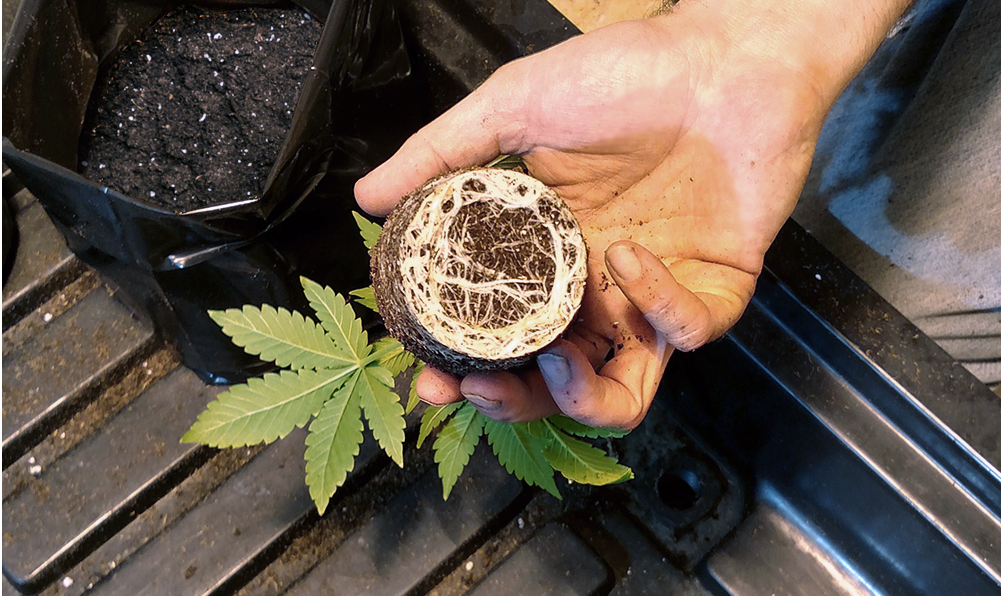Diversity of beneficial biology and the use of bio-stimulants can play a crucial role in the cultivation of the cannabis crop. A diverse biology creates a synergetic relationship with the host plant, resulting in multiple modes of action.
- Improved biology builds nutrient density that improves a plant’s capability to withstand pathogen and insect/pest pressure.
- Competitive exclusion on tissue surfaces and root system naturally engages the plant’s autoimmune defense mechanisms.
- Capture of atmospheric gasses
- Opportunity for increased yields, elevating terpenoid (terp) values and total oil values (trichome stacking) for increased “overall” compound values (THC, CBD, CBN, etc.).
- Diverse biology reduces and/or eliminates the need for fungicide and pesticide usage, which can aid in an increased ROI.
 Beneficial microbes both liberate nutrients from the soil and metabolize these essential nutrients into a more “friendly” or bioavailable form for nutrient uptake for a stronger more resilient plant. With greater plant nutrient density, a pest must expend more calories than it has the potential to consume from the host plant, making it an undesirable food source for the pest. As a result, the insect/pest must look for a more desirable food source for it to survive. By interrupting the pest’s reproduction cycle, one can reduce infestations.
Beneficial microbes both liberate nutrients from the soil and metabolize these essential nutrients into a more “friendly” or bioavailable form for nutrient uptake for a stronger more resilient plant. With greater plant nutrient density, a pest must expend more calories than it has the potential to consume from the host plant, making it an undesirable food source for the pest. As a result, the insect/pest must look for a more desirable food source for it to survive. By interrupting the pest’s reproduction cycle, one can reduce infestations.
Competitive exclusion is the proposition where two species with equal populations cannot coexist since they are fighting for the same resource. In this case, both pathogenic and beneficial microbes are competing for the “real estate” of the tissue surfaces of the host plant. The beneficial species are living in harmony with the plant, whereas the pathogenic species are competing for said real estate to rob the plant of nutrients.
Through the process of depositing beneficial microbes on root, stem, and leaf tissues of the plant (rhizosphere and phylosphere), beneficial microbes can overwhelm the pathogenic species making the host plant an unwelcoming environment for pathogens to take hold of the crop. Through regular applications of beneficial microbes, the plant has a greater opportunity to naturally “push back” on incoming disease pressures and/or aid in potentially overcoming a disease that has already set in.

One example is gram-positive bacteria consuming certain white molds. By incorporating beneficial biologicals into the irrigation or hand watering schedule and foliar applications, the plant has a layer of biological protection against incoming pathogens to overwhelm the pathogenic biology. This reduces and/or potentially eliminates the use of fungicides and pesticides. Beneficial biology can be a cost-effective tool to incorporate into the IPM program.
Plants live in symbiotic relationship with methylobacterium and endophytic bacteria, a bio-mechanism that allows the plant to capture atmospheric gases. Providing this bio-mechanism for the crop to utilize elements from both medium/soil and the atmosphere, the plant has the capacity to capture atmospheric nitrogen, mobilizing it appropriately as a nutrient source rather than just being dependent on root zone nitrogen and amino acids (peptides and polypeptides).

Beneficial biology has the potential to naturally engage the plants autoimmune defense mechanisms providing greater resiliency to incoming disease and pest pressure. This can be crucial during critical growth stages. Growers can ensure that the plant is less susceptible to pest and pathogen attack during these stages of seeding to encourage uniform emergence and establish a protective beneficial biological mucigenic sheath/layer on the roots, first penta-point leaf set, induction of flowering for indoor/controlled environments, sexual maturity, and early flower. Critical growth stages can be an opportunity for pests to be attracted to fresh, tender growth tissues, but are also opportunities for increased yields, rather than stressors that can inhibit the expression of the plant’s full genetic potential and consequently yields. Critical point beneficial microbial applications reduce stress. The plants will have greater resilience leading to potentially higher yields of total biomass, terpenoid, and overall compound values.
Incorporating a regimented schedule of a weekly and or bi-weekly application of beneficial microbes, such as Purple Cow CX-1 , is a great method to keep the bioactivity at a robust and competitive level for nutrient cycling, nutrient liberation and solubilization, nutrient fixation, and protection via bio-sanitation to stay in front of a possible pathogenic “attack.” Beneficial microbes create the opportunity for a complete bioactive growing system to reduce costs for a greater return-on-investment.
Broad-spectrum biologicals support many functions in your soil, and can support competitive exclusion, disease and pest suppression, nutrient uptake, and so much more in a single application. Click here to learn more about using CX-1, and the benefits that it can bring to greenhouses and more!
Want to learn more about CX-1, how to use it, and the benefits of adding a biological to your grow? Contact us here!


